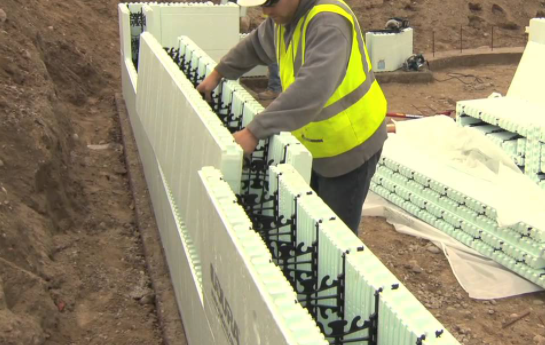Insulating concrete forms have a long history of success in low-rise buildings, but now Building Teams are specifying ICFs for mid- and high-rise structures—more than 100 feet. ICF walls can be used for tall unsupported walls (for, say, movie theaters and big-box stores) and for multistory, load-bearing walls (for hotels, multifamily residential buildings, and student residence halls).
Our trusted ICF experts offer the following tips for designing and constructing tall ICF walls:
1. Pre-plan your job by drawing a simple cross section with the ICF you are using.
The cross section will show you how openings line up with the coursing of the ICF joints and where embeds will be placed, says Glen Klassen, regional manager with ICF manufacturer Arxx, Cobourg, Ont. "During the build process, your crew can follow this cross section to know when to stop placing forms and start placing embeds."
2. Account for the ICF formwork course height.
Designers can greatly reduce the amount of formwork cuts the contractor will be required to make by considering the course height of the ICF product when designing the walls, says Kelvin Doerr, VP of engineering and technical services for Reward Wall Systems, Omaha, Neb. Doerr says architects should factor in wall heights, window heights, and floor elevations when possible.
3. Base concrete slump and aggregate size on ICF manufacturer recommendations.
Both concrete slump and aggregate size are impacted by the formwork tie configuration within the formwork cavity, as well as by the amount of open space available around the ties to allow concrete to effectively flow within the forms, says Donn C. Thompson, AIA, LEED AP, CGP, director of Low Rise Buildings with the Portland Cement Association, Skokie, Ill. "Ties with smaller openings will require smaller aggregate to insure the concrete flows effectively through the forms," he says.
Arxx's Klassen offers this rule of thumb: If the concrete is restricted slightly at the top form around the rebar before flowing into the wall, it's just right. If the concrete gets restricted to the point of not flowing down into the wall, it's too low of a slump. If the concrete flows freely into the wall with no restriction, it is likely too high a slump.
4. Consider the STC rating needed for the job.
Once you know the sound transmission class, consider what needs to be added to the ICF wall if an STC rating of 50 or higher is required, says John Krzic, accounts manager with Amvic Building System, Toronto. "For example, by adding a resilient channel to the ICF wall and then installing the drywall, it will increase the STC rating of the wall assembly," says Krzic.
5. Take steps to ensure the concrete completely fills the form.
"One concern with tall ICF walls is that concrete may not fill all parts of the form since the walls are generally thin," says Lionel Lemay, PE, SE, LEED AP, CAE, senior VP of sustainable development, National Ready Mixed Concrete Association, Silver Spring, Md. To help avoid holes and gaps in the concrete pour, Lemay advises the following:
-
Place a single layer of reinforcement in the center of the wall to allow for more space on either side of the reinforcement.
-
Allocate greater spacing of reinforcement than is required in ACI 318 14.5, which requires a maximum spacing of three times the wall thickness or 18 inches, whichever is smaller.
Consider using self-consolidating concrete. "Keep in mind that self-consolidating concrete exerts greater pressure on forms, so additional bracing will be required for most ICF systems," says Lemay.
6. Specify an ICF that is fully reversible.
"These forms have no top, bottom, left, or right side, and, therefore, are more efficiently stacked, reducing construction costs," says Reward's Doerr.
7. Repeat window patterns when possible.
In multistory load-bearing applications such as multifamily, senior living, and hotel projects, try to repeat window patterns from floor to floor so that the openings remain stacked for the full height of the wall assembly, says PCA's Thompson. This maximizes efficiency in design and construction.
8. Make sure, in noncombustible Type I, II, III, and IV multistory building projects, that the noncombustible floor system intersects the foam plastic on the interior of the building.
"The foam plastic must not be continuous from floor to floor, and special detailing is necessary to meet these requirements," says Doerr. In addition, IBC states that interior walls must be covered with a 15-minute thermal barrier. Doerr says half-inch gypsum board will do the trick.
9. Brace from the inside.
The higher the wall, the more difficult and costly it is to reach the exterior of the wall with bracing, says Amvic's Krzic. "Proper bracing will help to ensure that walls will be straight and level," he says. "This is important as it can affect other sub trades, wall finishes, and structural integrity of the building."
More on insulating concrete forms at:
13 tips on working with insulating concrete forms
How Insulated Concrete Forms Help Reduce Energy Consumption
English inspired church built with insulated concrete forms
Related Stories
University Buildings | Jan 11, 2022
Designing for health sciences education: supporting student well-being
While student and faculty health and well-being should be a top priority in all spaces within educational facilities, this article will highlight some key considerations.
Green | Jan 10, 2022
The future of regenerative building is performance-based
Why measuring performance results is so critical, but also easier said than done.
Urban Planning | Dec 15, 2021
EV is the bridge to transit’s AV revolution—and now is the time to start building it
Thinking holistically about a technology-enabled customer experience will make transit a mode of choice for more people.
Building Team | Nov 23, 2021
DLR Group and Atrius collaborate on smarter, healthier building spaces
DLR Group and Atrius announce strategic collaboration to make the industry’s leading air quality analytics platform even more powerful.
Giants 400 | Oct 22, 2021
2021 Sports Facilities Giants: Top architecture, engineering, and construction firms in the U.S. sports and recreation facility sector
AECOM, Populous, Kimley-Horn, and HOK top BD+C's rankings of the nation's largest sports and recreation facility sector architecture, engineering, and construction firms, as reported in the 2021 Giants 400 Report.
Multifamily Housing | Oct 21, 2021
Chicago’s historic Lathrop public housing complex gets new life as mixed-income community
A revitalized New Deal–era public housing community in Chicago brings the Garden City movement of yesteryear into the 21st century.
| Oct 14, 2021
The future of mass timber construction, with Swinerton's Timberlab
In this exclusive for HorizonTV, BD+C's John Caulfield sat down with three Timberlab leaders to discuss the launch of the firm and what factors will lead to greater mass timber demand.
Multifamily Housing | Oct 12, 2021
Affordable and sublime: 13 projects that represent the future of affordable housing
These projects prove that it’s possible to develop aesthetically pleasing, high-quality housing for low-income families, the homeless, and veterans.
Building Owners | Oct 12, 2021
6 ways building owners can own their construction projects
Building owners have an important role in executing their capital projects and can greatly increase their project’s chances of success by understanding and actively managing a few key factors.
AEC Tech Innovation | Oct 7, 2021
How tech informs design: A conversation with Mancini's Christian Giordano
Mancini's growth strategy includes developing tech tools that help clients appreciate its work.

















